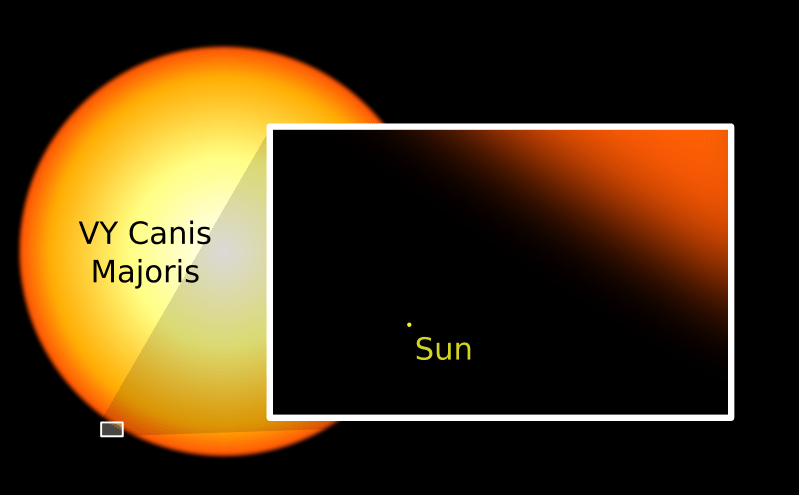75% of all the stars in the Universe are smaller and less massive than the Sun. Most of the others are similar in size and mass to the Sun, or maybe a little larger. But there are some very rare stars out there that are much larger and more massive than our Sun; these are the giant stars.
Blue Giant Stars
The color of a star depends on its temperature. The coolest stars are red, while the hottest stars are blue. And the temperature of a star depends entirely on its mass. If a star has enough mass, it will have a surface temperature greater than about 10,000 Kelvin and shine with a blue color. The largest and hottest stars in the Universe are these blue giant stars.
A familiar example is the blue giant star Rigel, located in the constellation of Orion, located about 700 to 900 light years away. Rigel contains 17 times the mass of the Sun, and shines with 40,000 times the luminosity of the Sun. This is enough energy for Rigel to light up dust clouds in its vicinity.
An even more extreme example is the blue hypergiant Eta Carinae, located about 8,000 light years away. Eta Carinae is a monster, estimated to have more than 100 times the mass of the Sun. It’s burning fuel at such a tremendous rate that it puts out 4 million times as much energy as the Sun, with a surface temperature of 40,000 Kelvin. Astronomers expect Eta Carinae to detonate as a supernova in a few hundred thousand years.
Blue giant stars are giant because they have many times the mass of the Sun.
Red Giant Stars
On the other end of the spectrum are the red giant stars. While blue is the hottest color of stars, red is the coolest color they can have. A red giant is born when a star like our Sun reaches the end of its life and runs out of hydrogen fuel in its core. This forces the star to begin nuclear fusion with helium, increase in luminosity and bloat up many times its original size. When our Sun becomes a red giant, it will expand to consume the orbits of the inner planets, including Mercury, Venus and Earth.
So, regular stars become regular red giants. But there are even larger red giants out there; the red supergiants. These are massive stars with more than 20 times the mass of the Sun. They enter the red giant phase of stellar evolution, but instead of merely expanding to the orbit of the Earth, they can expand to more than 1,500 times the radius of the Sun. Imagine a star that extended out past the orbit of Saturn.
We have written many articles about stars here on Universe Today. Here’s an article about the biggest star in the Universe, and here’s an article about a planet surviving when its star became a red giant.
If you’d like more information on stars, check out Hubblesite’s News Releases about Stars, and here’s the stars and galaxies homepage.
We have recorded several episodes of Astronomy Cast about stars. Here are two that you might find helpful: Episode 12: Where Do Baby Stars Come From, and Episode 13: Where Do Stars Go When they Die?
References:
http://en.wikipedia.org/wiki/Blue_giant
http://earthsky.org/brightest-stars/blue-white-rigel-is-orions-brightest-star
http://www.telescope.org/pparc/res8.html

